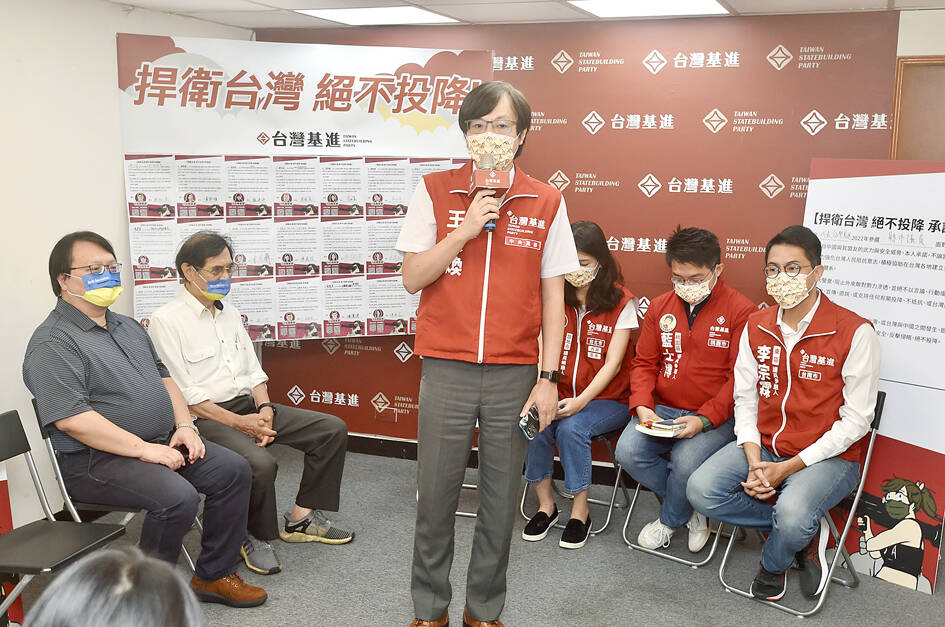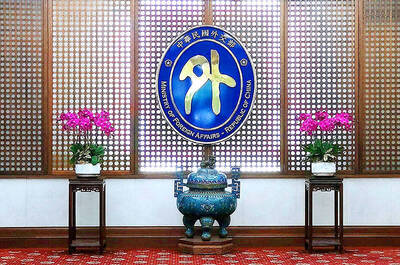The Taiwan Republic Office conducted a flag-raising ceremony in Taipei yesterday to support Taiwanese sovereignty, while Taiwan Statebuilding Party (TSP) members held a separate event in which they signed a pledge to defend Taiwan in the event of an attack.
As has become an annual tradition, the office and sovereignty supporters gathered at a cordoned-off section of Ketagalan Blvd next to the Taipei Guest House to fly the green-and-white independence flag displaying a chrysanthemum emblem in the center.
The assembled crowd saluted the flag before being addressed by guest speakers, including organization founder Peter Wang (王獻極), who said he was proud to have conducted the ceremony for the past 18 years.

Photo: Tsung Chang-chin, Taipei Times
Wang said that Sept. 8 should be marked as Taiwan Independence Day, as the date is the anniversary of the signing of the Treaty of San Francisco in 1951, in which Japan agreed to relinquish its claim to Taiwan.
“The sovereignty of Taiwan belongs to all of us here, all the families and inhabitants of Taiwan,” Wang said.
“The evil Chinese Communist Party wants to attack us, to take over by military force, and lie to the world by claiming Taiwan is part of China,” he added.
Wang and other advocates at the event signed a pledge to “defend Taiwan and never surrender,” before mounting a large banner on a campaign truck that read: “We shall fight to the death if communist Chinese troops try to invade Taiwan; awake people to build a Taiwan nation for international participation.”
“When President Tsai Ing-wen (蔡英文) visits towns and villages, she always talks of herself as president of Taiwanese people. So we ask her not to forget the many martyrs who shed blood and sacrificed their life in fighting for democracy against the Chinese Nationalist Party (KMT) dictatorship,” Wang said.
“Now is the time to discard the outdated KMT symbol on the current national flag, along with the KMT party song masquerading as the national anthem,” he said, adding that a new Constitution should be drafted.
Members of the TSP at a separate event also made a pledge.
“All 24 party candidates contesting city and county council seats, along with party officials, are signing this pledge,” to defend Taiwan against enemy attack, TSP secretary-general Wang Hsing-huan (王興煥) said.
The pledge was launched on Monday by World United Formosans for Independence (WUFI) and other sovereignty support groups.
“We are Taiwan’s first political party to have all its members sign this pledge. This shows our strong resolve to act on our conviction, Wang Hsing-huan said.
“All politicians and government officials must make their stance clear now about how they would respond to a Chinese military attack,” he added.
Wang Hsing-huan and Peter Wang criticized Taipei City Mayor Ko Wen-je (柯文哲) and possible presidential candidate for refusing to sign the pledge.
Peter Wang added that Ko’s actions as mayor have demonstrated collaboration with China.
WUFI chairman Chen Nan-tien (陳南天) and Kuma Academy cofounder Ho Cheng-hui (何澄輝) joined the party’s event and urged voters not to cast ballots for candidates who do not sign the pledge.
“People must not give votes to pro-China political parties, for those who pander to China should no longer operate here in Taiwan,” Chen said.

The Ministry of Foreign Affairs (MOFA) yesterday voiced dissatisfaction with the Comprehensive and Progressive Agreement for Trans- Pacific Partnership (CPTPP), whose latest meeting, concluded earlier the same day, appeared not to address the country’s application. In a statement, MOFA said the CPTPP commission had "once again failed to fairly process Taiwan’s application," attributing the inaction to the bloc’s "succumbing to political pressure," without elaborating. Taiwan submitted its CPTPP application under the name "Separate Customs Territory of Taiwan, Penghu, Kinmen and Matsu" on Sept. 22, 2021 -- less than a week after China

THE GOOD WORD: More than 100 colleges on both sides of the Pacific will work together to bring students to Taiwan so they can learn Mandarin where it is spoken A total of 102 universities from Taiwan and the US are collaborating in a push to promote Taiwan as the first-choice place to learn Mandarin, with seven Mandarin learning centers stood up in the US to train and support teachers, the Foundation for International Cooperation in Higher Education of Taiwan (FICHET) said. At the annual convention of the American Council on the Teaching of Foreign Languages held over the weekend in New Orleans, Louisiana, a Taiwan Pavilion was jointly run by 17 representative teams from the FICHET, the Overseas Community Affairs Council, the Steering Committee for the Test of Proficiency-Huayu, the

A home-style restaurant opened by a Taiwanese woman in Quezon City in Metro Manila has been featured in the first-ever Michelin Guide honoring exceptional restaurants in the Philippines. The restaurant, Fong Wei Wu (豐味屋), was one of 74 eateries to receive a “Michelin Selected” honor in the guide, while one restaurant received two Michelin stars, eight received one star and 25 were awarded a “Bib Gourmand.” The guide, which was limited to restaurants in Metro Manila and Cebu, was published on Oct. 30. In an interview, Feng Wei Wu’s owner and chef, Linda, said that as a restaurateur in her 60s, receiving an

Kaohsiung Mayor Chen Chi-mai (陳其邁) on Monday announced light shows and themed traffic lights to welcome fans of South Korean pop group Twice to the port city. The group is to play Kaohsiung on Saturday as part of its “This Is For” world tour. It would be the group’s first performance in Taiwan since its debut 10 years ago. The all-female group consists of five South Koreans, three Japanese and Tainan’s Chou Tzu-yu (周子瑜), the first Taiwan-born and raised member of a South Korean girl group. To promote the group’s arrival, the city has been holding a series of events, including a pop-up